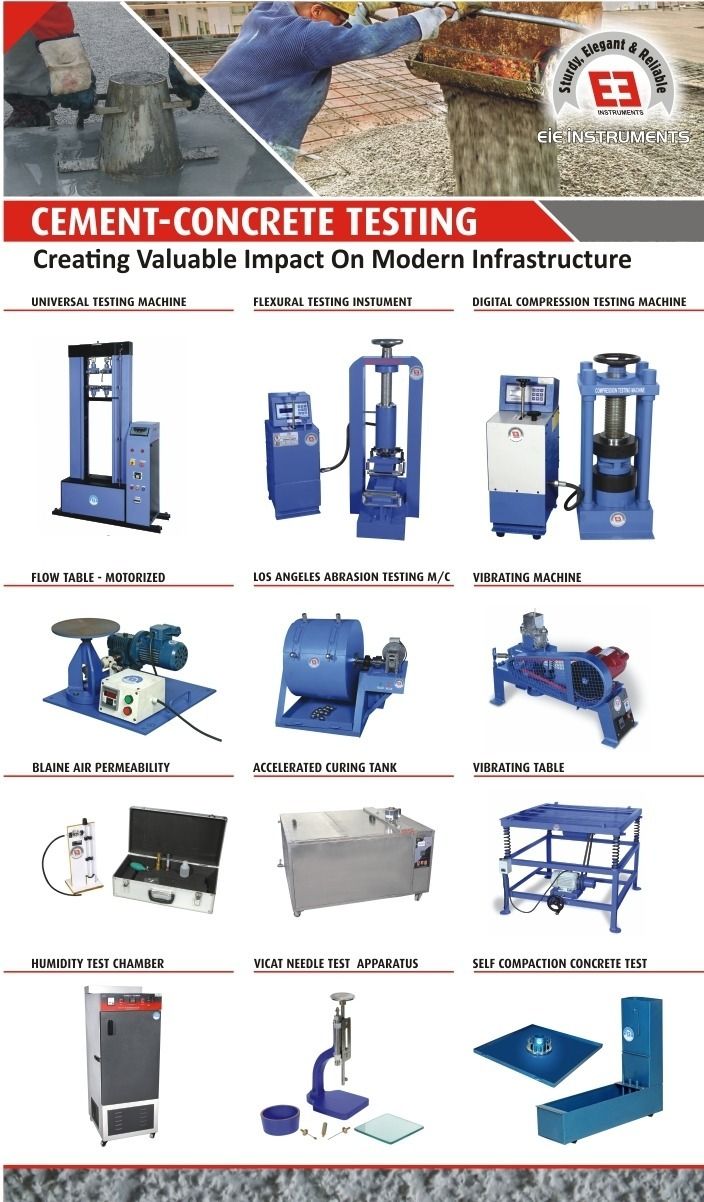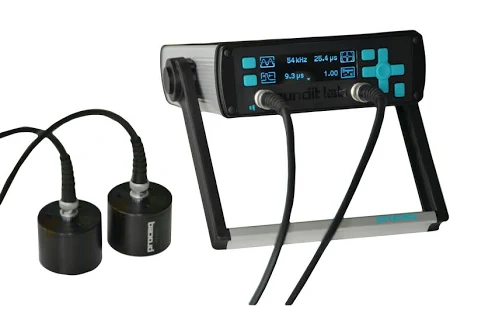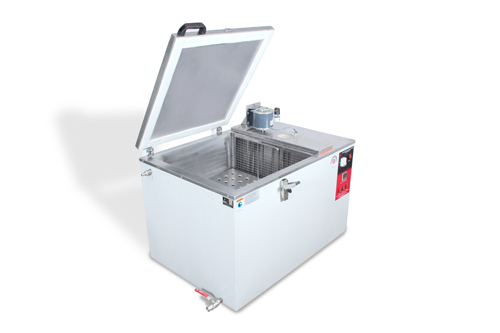DRYING SHRINKAGE APPARATUS
Price 1.00 INR/ Piece
DRYING SHRINKAGE APPARATUS Specification
- Accuracy
- 0.005 mm (dial gauge minimum division)
- Test Range
- 0-10 mm (depending on dial gauge)
- Number of Specimens
- 1 per measurement
- Humidity
- Ambient lab conditions
- Features
- Robust design, corrosion resistant, easy specimen placement
- Equipment Type
- Drying Shrinkage Apparatus
- Hardness
- Frame made of hardened steel
- Product Type
- Shrinkage Mould
- Application
- Consist of a measuring apparatus incorporating a suitable dial gauge reading accurately to 0.005 mm
- Resolution
- 0.005 mm
- Interface Type
- None (mechanical)
- Response Time
- Immediate/manual
- Max Height
- Approx. 150 mm specimen clearance
- Display Type
- Analog dial gauge
- Mounting Type
- Bench-top
- Automation Grade
- Manual
- Usage
- Concrete Testing Equipment
- Temperature
- Ambient lab conditions (10C to 40C)
- Power Supply
- Not required (manual instrument)
- Measuring Range
- 0-10 mm
- Capacity
- One specimen at a time
- Machine Weight
- Approx. 6-10 kg
- Test Speed
- Manual measurement (static)
- Test Width
- Preferred specimen width 25 mm
- Test Stroke
- Range up to 100 mm
- Control Mode
- Manual
DRYING SHRINKAGE APPARATUS Trade Information
- Minimum Order Quantity
- 1 Piece
- Supply Ability
- 100 Pieces Per Month
- Delivery Time
- 8 Week
- Sample Policy
- Contact us for information regarding our sample policy
- Packaging Details
- Wooden Box / Corrugated Box
- Certifications
- ISO 9001 : 2015
About DRYING SHRINKAGE APPARATUS
Details
Consist of a measuring apparatus incorporating a suitable dial gauge reading accurately to 0.005 mm. This gauge will be rigidly mounted in a measuring Frame and will have a recessed end which can be located upon a 6.5 mm diameter ball or other reference pointcemented in the specimen. The other end of the frame will have a similar recessed seating which can be located upon a second ball or reference point in the specimen. An invar steel rod of a suitable length with 6.5 mm diameter steel ball or hemispherical ends can be used as a standard of length against which the readings of the gauge can be tested. The apparatus will be designed to test Mould of 75mm x 75mm x 300mm long concrete specimen.
Further details availableon our website.
The Price mentioned here are subject to change as per the capacity,specifications and application of the user.
Accurate Concrete Shrinkage Measurement
The apparatus delivers high accuracy in determining drying shrinkage of concrete specimens. Its dial gauge reads down to 0.005 mm, providing immediate and precise measurement of changes during the drying process. This ensures reliable data collection for cement and concrete testing research.
Durable and User-Friendly Design
Constructed with a powder-coated or painted mild steel frame, the apparatus is resistant to corrosion and suited for regular laboratory usage. Specimen placement is easy and repeatable due to its well-designed supports and rollers, which facilitate precise alignment during testing. Accessories such as a measurement template and permanent marker are included for convenience.
Manual Operation for Flexible Testing
The device operates without a power supply, supporting manual measurement and control mode. Suitable for ambient lab conditions (10C to 40C), it accommodates a single specimen per test up to 25 mm width and 100 mm stroke, catering to standard shrinkage tests in concrete labs.
FAQs of DRYING SHRINKAGE APPARATUS:
Q: How do I use the Drying Shrinkage Apparatus for testing concrete specimens?
A: To test a specimen, place it onto the apparatus supports or rollers, ensuring precise alignment. Use the plunger-type dial gauge to measure shrinkage changes. Record the readings manually as the specimen dries, using the supplied permanent marker and measurement template for marking reference points.Q: What benefits does the mild steel frame and powder-coated finish provide?
A: The mild steel frame offers structural strength and is powder-coated or painted for enhanced durability. This finish improves corrosion resistance, ensuring longevity and consistent performance in laboratory environments exposed to humidity and varying temperatures.Q: When is this apparatus typically employed during concrete testing?
A: The drying shrinkage apparatus is used after preparing specimen samples, typically during the curing and drying phases of concrete. It is essential for determining shrinkage characteristics in research, quality assurance, and material development processes.Q: Where should I set up the Drying Shrinkage Apparatus in the laboratory?
A: This equipment is designed for bench-top mounting on a stable laboratory surface. Ensure the setup is within ambient temperature and humidity conditions (between 10C to 40C) for optimal measurement accuracy and consistent test results.Q: What is the process for measuring shrinkage with this apparatus?
A: The process involves aligning the concrete specimen, setting the dial gauge to zero, and manually monitoring shrinkage changes over time. Measurements are taken at regular intervals, with the gauge providing analog readings instantly, enabling detailed tracking of specimen deformation.Q: What usage capacity does the apparatus offer?
A: The device accommodates one specimen per measurement, with a preferred specimen width of 25 mm and up to 100 mm test stroke. Its manual operation ensures simple and flexible use for repeated concrete shrinkage determinations.Q: How does the apparatus ensure precise results and measurement reliability?
A: The plunger-type dial gauge provides high resolution (0.005 mm minimum division) with immediate readings. The robust frame, accurate specimen alignment, and corrosion-resistant construction contribute to precise, repeatable, and reliable shrinkage measurements for concrete testing.


Price:
- 50
- 100
- 200
- 250
- 500
- 1000+
More Products in Concrete Testing Equipment Category
Ultrasonic Concrete Tester
Price 1.00 INR / Piece
Minimum Order Quantity : 1 Piece
Application : Nondestructive testing of concrete quality, thickness, and uniformity
Temperature : 0C to 40C
Machine Weight : 3 kg
Usage : Concrete compressive strength and quality evaluation
Flow Table for Concrete - 700 x 700 MM
Price 1.00 INR / Piece
Minimum Order Quantity : 1 Piece
Application : Slump and Flow Testing of Fresh Concrete
Temperature : Standard Lab Conditions
Machine Weight : Approx. 45 kg
Usage : For Concrete Testing
Accelerated Curing Tank- With Heating And Cooling
Price 1.00 INR / Piece
Minimum Order Quantity : 1 Piece
Application : Concrete cube accelerated curing
Temperature : Ambient to 100C (with heating and cooling)
Machine Weight : 130 kg approx.
Usage : Laboratory concrete curing
Concrete Mixer
Price 1.00 INR / Piece
Minimum Order Quantity : 1 Piece
Application : Mixing of cement, sand, gravel and water for construction works
Machine Weight : 320 kg
Usage : Construction site concrete mixing
 |
EIE INSTRUMENTS PVT. LTD.
All Rights Reserved.(Terms of Use) Developed and Managed by Infocom Network Private Limited. |

 Send Inquiry
Send Inquiry




